How to Find Customer Pain Points: 5 Proven Research Methods
The critical gap isn't in your team's talent—it's in truly understanding customer pain points. Product strategists and market researchers are constantly wrestling with the same challenge: how to systematically uncover the genuine, unspoken needs that drive purchasing decisions. Without precise insights, you're essentially building solutions in the dark, risking significant time, resources, and potential market momentum.
What if you could transform your research approach from guesswork to a strategic, repeatable process? This guide reveals five proven methods to dig deeper than surface-level feedback, helping you unearth the profound customer insights that differentiate successful products from forgettable ones.
Understanding the Challenge of Identifying Customer Pain Points
Root Causes of Customer Insight Failures
B2B organizations frequently struggle to uncover genuine customer pain points due to several critical underlying issues:
- Assumption-Driven Research: Leadership teams often rely on internal perceptions rather than direct customer experiences, creating a dangerous echo chamber of misaligned insights.
- Fragmented Communication Channels: Siloed departments prevent comprehensive understanding of customer interactions and feedback loops.
- Insufficient Research Methodologies: Traditional survey techniques and superficial feedback collection fail to reveal deeper, nuanced customer challenges.
- Lack of Systematic Insight Gathering: Most organizations lack a structured approach to consistently and systematically capture customer perspectives.
Recognizable Symptoms of Poor Customer Insight
Organizations experiencing challenges with customer pain point identification typically exhibit these telling signs:
Product Misalignment
Developing solutions that generate minimal market traction or fail to address genuine customer needs, resulting in low adoption rates and poor market reception.
Ineffective Messaging
Marketing campaigns and value propositions that do not resonate with target audience expectations, leading to diminished engagement and conversion rates.
Resource Wastage
Investing significant engineering and development resources into features or products that customers do not find compelling or necessary.
Strategic Implications of Neglecting Customer Pain Points
The consequences of failing to systematically identify and address customer pain points extend far beyond immediate product development challenges:
Business Impact
Potential Consequences
Competitive Positioning
Competitors who better understand customer needs will rapidly capture market share and mindspace
Customer Retention
Higher churn rates as clients seek solutions that more precisely address their specific challenges
Financial Performance
Reduced revenue potential and increased customer acquisition costs due to misaligned value propositions
Innovation Effectiveness
Diminished ability to create breakthrough solutions that genuinely transform customer experiences
Understanding these root causes, symptoms, and strategic implications creates a compelling case for developing a more sophisticated approach to customer pain point research—one that goes beyond superficial feedback and delivers actionable, transformative insights.
5-Step Framework for Systematic Customer Pain Point Discovery

Step 1: Comprehensive Data Collection Strategy
Transform customer feedback gathering from passive to proactive. Deploy multi-channel insight collection including:
- Sales call transcription analysis
- Customer support ticket categorization
- Exit interview frameworks
- Net Promoter Score (NPS) tracking
Step 2: Advanced Customer Segmentation Techniques
Move beyond demographic clustering to create behavioral and psychographic segments that reveal nuanced pain points. Utilize:
- Advanced CRM segmentation tools
- Machine learning clustering algorithms
- Cross-functional persona development workshops
Step 3: Qualitative Research Deep Dive
Implement targeted research methodologies to extract profound customer insights:
- Jobs-to-be-Done (JTBD) interview protocols
- Contextual inquiry sessions
- Ethnographic research techniques
- Narrative-based feedback collection
Step 4: Quantitative Validation Mechanisms
Translate qualitative insights into measurable, prioritizable data points through:
- Structured pain point impact scoring
- Statistical significance testing
- Conjoint analysis frameworks
- Competitive benchmark mapping
Step 5: Continuous Insight Refinement
Establish perpetual feedback loops that dynamically adapt to evolving customer needs:
- Regular cross-functional insight sharing
- Real-time customer signal monitoring
- Quarterly strategic insight reviews
- Predictive trend analysis platforms
Critical Implementation Considerations
Successful pain point discovery requires:
- Leadership commitment to insights-driven strategy
- Investment in advanced research technologies
- Cultural openness to challenging existing assumptions
- Rigorous data privacy and ethical research practices
Strategic Implementation: Navigating Challenges in Customer Pain Point Research
Common Implementation Obstacles
Even with a robust framework, B2B organizations encounter specific challenges when diving deep into customer pain point research:
Data Fragmentation
Customer insights are often scattered across multiple systems, departments, and communication channels, making comprehensive analysis difficult.
Resource Constraints
Limited budgets and specialized research skills can restrict the depth and breadth of customer insight gathering, particularly for smaller organizations.
Organizational Resistance
Internal teams may be reluctant to challenge existing assumptions or invest time in comprehensive research methodologies.
Strategic Workarounds and Solutions
-
Data Integration Strategy
Implement lightweight integration tools like Zapier or custom API connections to consolidate customer feedback from CRM, support tickets, and sales platforms. Focus on creating a centralized insight repository that requires minimal manual intervention.
-
Lean Research Approaches
Leverage cost-effective research methods such as:
- Open-source survey tools like Google Forms
- Low-cost video interview platforms
- Community-driven feedback networks
- Collaborative research partnerships with industry peers
-
Change Management Techniques
Drive organizational buy-in through:
- Pilot programs demonstrating tangible research value
- Concise, visual insight presentations
- Incremental research investments
- Cross-functional insight sharing sessions
Critical Insight
Successful customer pain point research isn't about perfection—it's about consistent, iterative learning. Start small, remain adaptable, and continuously refine your approach.
Transformative Benefits: The Strategic Value of Comprehensive Customer Pain Point Research

Implementing a rigorous customer pain point discovery framework delivers exponential returns across multiple business dimensions, transforming organizational performance and market positioning.
Revenue Impact
- Average 25-40% increase in product-market fit
- Potential 35% reduction in customer acquisition costs
- Up to 22% improvement in sales conversion rates
Product Development
- 50% faster time-to-market for validated solutions
- Reduced feature development waste by approximately 60%
- Enhanced product roadmap precision
Customer Experience
- 15-20% improvement in customer satisfaction scores
- Enhanced customer retention rates
- More personalized engagement strategies
Strategic Transformation Indicators
Beyond immediate metrics, organizations implementing systematic customer pain point research experience profound strategic shifts:
- Elevated competitive positioning
- More responsive innovation cycles
- Data-driven decision-making culture
- Predictive market intelligence capabilities
Measurable Return on Research Investment
Businesses leveraging advanced customer insight methodologies report average ROI ranging from 3:1 to 5:1, with leading organizations achieving even more substantial performance improvements across product development, marketing, and sales functions.
Conclusion: Transforming Customer Insights into Strategic Advantage
Uncovering and addressing customer pain points is not merely an academic exercise but a strategic imperative for B2B technology organizations seeking meaningful market differentiation. By systematically employing advanced research methodologies—from sophisticated qualitative techniques like ethnographic interviews to quantitative data analysis using advanced sentiment and behavioral mapping—professionals can transform raw insights into actionable strategic intelligence. The most successful organizations view customer pain point discovery as a continuous, iterative process that goes beyond surface-level feedback, diving deep into underlying psychological and operational constraints that inhibit customer success. Ultimately, the goal is not just to identify problems but to develop nuanced, innovative solutions that demonstrate a profound understanding of customer challenges, thereby positioning your product or service as an indispensable strategic partner rather than a transactional commodity.
